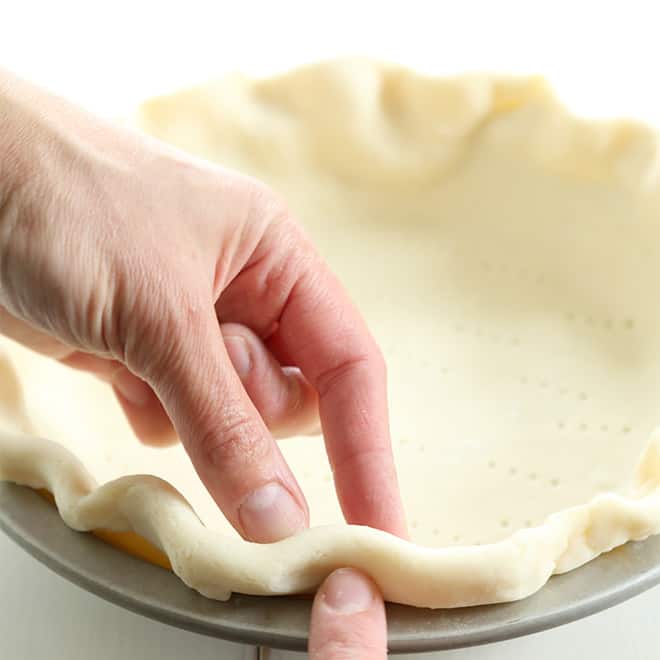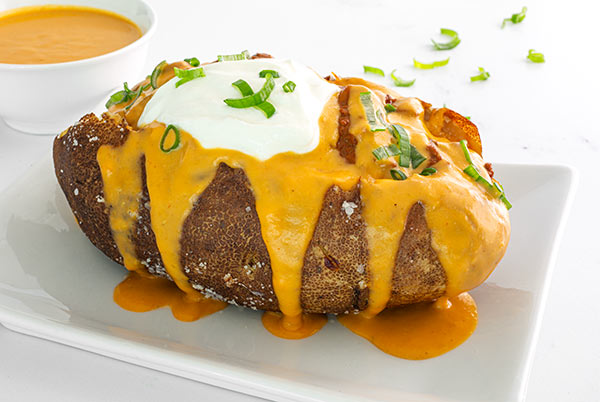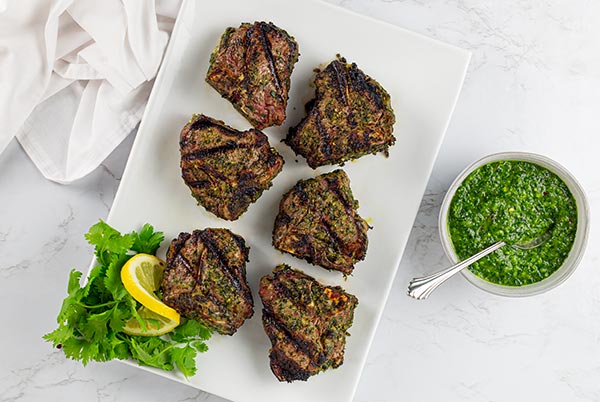Prepare an extra flaky, gluten free pie crust when you follow this recipe. Whatever pie you’re craving, this is the only gf pie crust recipe you need.
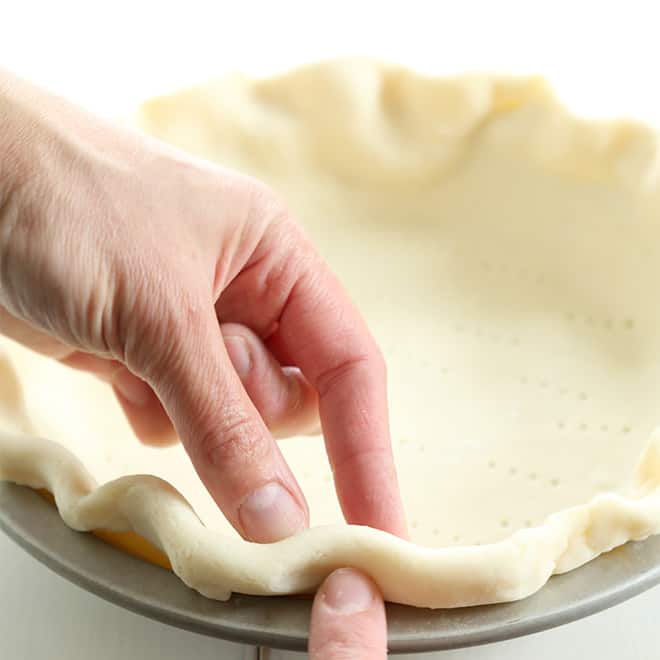
This extra flaky gluten free pie crust is made with sour cream and rolls out beautifully. You can have the perfect recipe for pie crust in your baking toolbox. It’s right here!

Before cookie season comes pie season. That means that we need light and extra flaky gluten free pie crust, and plenty of it. Actually, pie season is really any season. In the summertime, we make pies with summer berries and stone fruits. In the fall and winter, it’s all about apple pie, and maybe a pecan pie or two.
Why this is the best gluten free pie crust recipe ever
For years and years (and years), I’d used another recipe that doesn’t call for sour cream almost exclusively for single and double crust pies alike. And it’s still one of my favorites. But this extra flaky one?
This perfect pie crust is giving my regular gluten free pastry crust a run for its money. It rolls out so beautifully and is just effortlessly flaky. Like all pastry-baking, you just have to be sure to keep everything cold cold cold while you’re working with it.
My hope is that you never feel like you have to buy a pre-made crust. Have you ever tried one of those? They’re just not up to our standards. 🙂
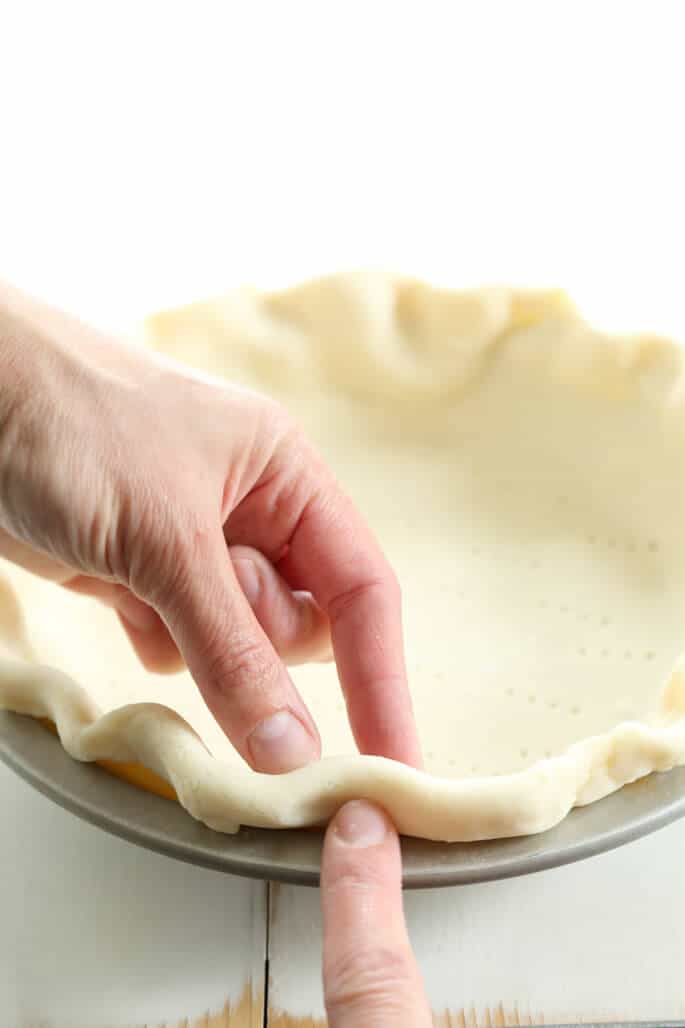
Making an extra flaky gluten free pie crust
My basic principles of flaky pastry-making remain the same. Begin with relatively large chunks of butter (no pea-sized bits, please!), coat them in dry ingredients and then flatten them between your thumb and forefinger.
That way, when the butter melts a bit as you’re working with the pastry, it will firm back up when you chill the shaped pastry. This time, though, rather than using ice water to bring the dough together, it’s sour cream. Sour cream adds a tenderness to the dough that is like nothing else.
Be sure to lift the pie crust up and into the bottom and sides of the pie plate rather than attempting to stretch it. That’ll keep it from shrinking during baking.
If you’re a visual learner, I’ve created a how-to video to help show every stage of pie-crust making. It’s right above the recipe itself.

The secret is in the sour cream
I’ve included instructions for parbaking the crust, but your gluten free pie recipe may or may not require that step. Extra tender and extra flaky?
That’s right. Thank you, sour cream! Whether you’re already planning your gluten free Thanksgiving, or still baking up the best of summer’s stone fruits, you can fill this gorgeous crust with all your favorites.
Gluten free pie crust: substitutions
Gluten free, dairy free crust
I often get asked about making this extra flaky gluten free pie crust dairy free. My first and best suggestion is instead to use my recipe for a classic pie crust, and replace the butter with butter-flavored Spectrum nonhydrogenated vegetable shortening. It’s a much easier swap, and that is a truly lovely pie crust.
Be sure your all purpose gluten free flour blend is dairy-free, as well, if you’re going to make that recipe dairy-free. I recommend my Better Than Cup4Cup blend in pastries like pie crust, which contains milk powder, so be sure to use coconut milk powder to make the blend dairy-free.
But if you’d like to stick with this recipe, I’d try the same swap for butter, and try replacing the sour cream with either Greek-style (strained and thickened) plain nondairy yogurt, or nondairy sour cream. I have not tried that swap, though, so you’ll have to experiment!
Gluten free, vegan crust
The only animal products in this or the other pie crust recipe are those derived from dairy. Since there’s no meat and no eggs, if you follow the instructions for making this recipe dairy-free, it will also be vegan.
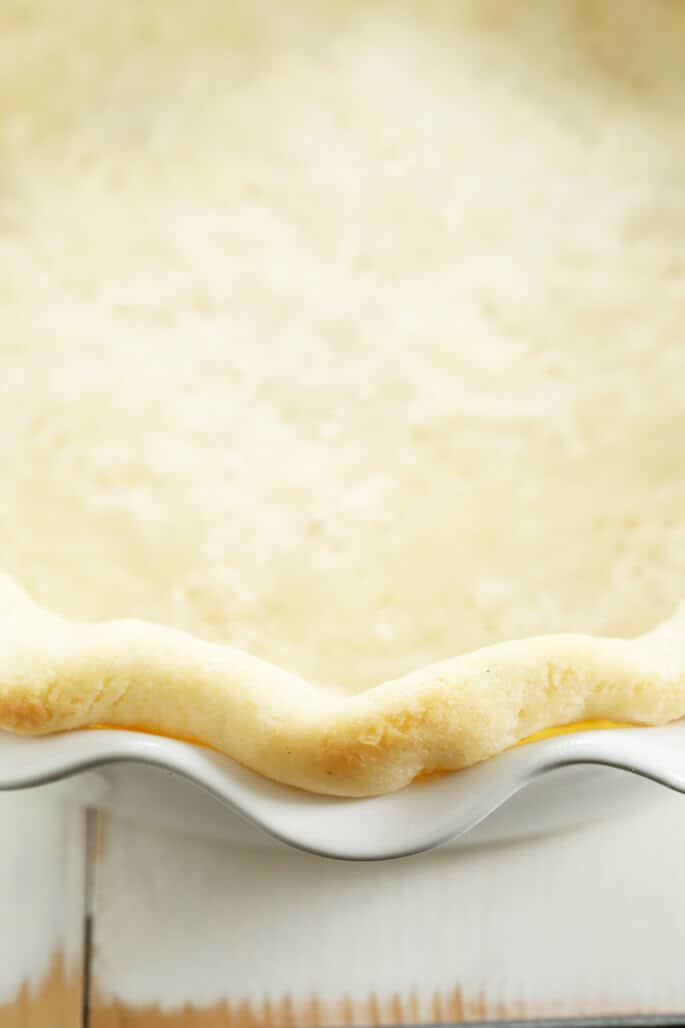
FAQs
Is pie crust gluten free?
No! Pie crust is not gluten free, unless, like this recipe it is made to be gluten free. You must use gluten free flour, not conventional wheat flour, and balance the other ingredients accordingly.
How does an extra flaky gluten free pie crust actually taste?
Gluten free pie crust, when made with the right ingredients, right recipe, and the right technique, tastes light and flaky, but tender and never dry. It enhances every filling, just like the best pastry crusts do!
What’s the secret to an extra flaky crust?
The secret to an extra flaky gluten free pie crust is adding a bit of cold sour cream to the mixture. That helps create some extra tenderness without compromising any of the layered flakiness.
Why is it important to keep pastry ingredients cold?
All pastries should be made with cold ingredients, and pie crust is no exception. The cold ingredients, especially the fat (usually butter, but sometimes lard or solid coconut oil or shortening) expand when they hit the heat of the preheated oven and push out the surrounding dry ingredients, creating those flaky, crispy layers we all love.
What’s the best gluten free flour for pie crust?
The best gluten free flour for flaky pie crust is a version of our gluten free pastry flour, which has some milk powder and some extra cornstarch for lightness and tenderness.
Can I use a food processor or stand mixer for this recipe?
I don’t recommend making this pie crust using anything other than a bowl and a spoon, since that makes it possible to create large but flat solid pieces of fat that are evenly distributed throughout the raw dough. That’s how you get those layers!
The common method of making the pie crust into “pea-sized pieces” tends to make tougher crusts. A stand mixer is a definite no, but if you must use a food processor, process the dough as little as possible!
Can I use a glass pie pan for this recipe?
Yes, you can bake this crust in a glass pie pan, which will allow you to see the bottom of the crust and accurately judge how much it has browned. Baking in glass is similar to baking in porcelain, as both retain heat very well, so watch carefully to ensure you don’t burn your crust.
How do you crimp the edges of a pastry crust?
To crimp the edge, place the thumb and forefinger of one hand about 1-inch apart on the edge of the pie crust pointing from the inside out. From the outside in, press the knuckle of the forefinger of your other hand in the center of the other two fingers.
Gently pinch the inside fingers together around the outside knuckle. Move around the whole perimeter of the crust, repeating the process inch by inch, and you’ll have a beautiful crimped edge!
How do you know when the crust is ready?
If you’re parbaking your crust, as directed here in this gluten free pie crust recipe, you’ll know it’s done baking when it is very lightly golden brown on the edges. The bottom of the crust should only be less shiny, but not browned, which will finish when you fill and finish baking.
Extra Flaky Gluten Free Pie Crust
Prepare an extra flaky, gluten free pie crust when you follow this recipe. Whatever pie you’re craving, this is the only gf pie crust recipe you need.
Yield: 1 10-inch pie crust
Prevent your screen from going dark
Ingredients
- 1 ½ cups (210 g) all purpose gluten free flour blend I highly recommend Cup4Cup, my Better Than Cup4Cup blend, my Mock Cup4Cup, or my Better Batter Pastry Hack blend, plus more for sprinkling
- ¾ teaspoon xanthan gum omit if your blend already contains it
- ¼ teaspoon baking powder
- ½ teaspoon kosher salt
- 6 tablespoons (84 g) unsalted butter roughly chopped and chilled
- ½ cup (120 g) sour cream full fat, preferably, chilled
- Ice water by the teaspoonful as necessary
Instructions
Make the pie crust dough.
-
In a large bowl, place the flour, xanthan gum, baking powder and salt, and whisk to combine well. Add the chopped and chilled butter, and toss to coat it in the dry ingredients.
-
Flatten each chunk of butter between your thumb and forefinger. Add the sour cream, and mix to moisten the dry ingredients with the sour cream. The dough should be shaggy and somewhat crumbly.
-
Knead the dough together with clean hands until it begins to come together. Add ice water by the teaspoon only if necessary for the dough to hold together.
-
Turn the dough out onto a sheet of plastic wrap, and press into a disk as you close the plastic wrap around the dough. It will still seem rough. Place the dough in the refrigerator to chill for 30 minutes.
-
Preheat your oven to 375°F. Grease a 9-inch metal pie plate generously and set aside.
Smooth out the chilled dough.
-
Once the dough has chilled, turn it out onto a lightly floured piece of unbleached parchment paper. Sprinkle the dough lightly with more flour, and roll it out into a rectangle that is about 1 inch thick, moving the dough frequently and sprinkling it lightly with flour if it begins to stick.
-
Fold the dough over on itself like you would a business letter. Sprinkle the dough again lightly with flour, and roll out the dough once again into a rectangle about 1 inch thick.
-
Twice more, remove the top piece of parchment paper, sprinkle lightly with flour, and fold the dough over on itself like you would a business letter.
Shape the dough in the pie plate.
-
Roll out the dough into an approximately 12-inch round, about 3/8-inch thick. Roll the pie crust loosely onto the rolling pin and then unroll it over the prepared pie plate.
-
Trim the roughest edges of the crust with kitchen shears. Lift up the edges of the pie crust gently to create slack in the crust, and place the crust into the bottom and up the sides of the pie plate.
-
Tuck the excess pie crust under itself, and crimp the edge gently all the way around the crust by pinching the dough at regular intervals with one hand, and creating a crimped impression with the forefinger of the other hand. Cover the pie crust with plastic wrap and place it in the refrigerator to chill until firm, at least 30 minutes (and up to 3 days).
Parbake the crust.
-
Remove the pie crust from the refrigerator and unwrap and discard the plastic. Pierce the bottom of the pie crust all over with the tines of a fork.
-
Place a sheet of parchment paper on top of the raw crust and cover the bottom of the crust with pie weights or dried beans.
-
Place in the center of the preheated oven and bake until the crust is lightly golden brown on the edges, about 10 minutes.
-
Remove the pie weights and parchment and allow the crust to cool before proceeding with your recipe.
Notes
Originally published on the blog in Fall 2015. Recipe and photos unchanged, text revised slightly, video brand new.
Extra Flaky Gluten Free Pie Crust
Prepare an extra flaky, gluten free pie crust when you follow this recipe. Whatever pie you’re craving, this is the only gf pie crust recipe you need.
Yield: 1 10-inch pie crust
Prevent your screen from going dark
Ingredients
- 1 ½ cups (210 g) all purpose gluten free flour blend I highly recommend Cup4Cup, my Better Than Cup4Cup blend, my Mock Cup4Cup, or my Better Batter Pastry Hack blend, plus more for sprinkling
- ¾ teaspoon xanthan gum omit if your blend already contains it
- ¼ teaspoon baking powder
- ½ teaspoon kosher salt
- 6 tablespoons (84 g) unsalted butter roughly chopped and chilled
- ½ cup (120 g) sour cream full fat, preferably, chilled
- Ice water by the teaspoonful as necessary
Instructions
Make the pie crust dough.
-
In a large bowl, place the flour, xanthan gum, baking powder and salt, and whisk to combine well. Add the chopped and chilled butter, and toss to coat it in the dry ingredients.
-
Flatten each chunk of butter between your thumb and forefinger. Add the sour cream, and mix to moisten the dry ingredients with the sour cream. The dough should be shaggy and somewhat crumbly.
-
Knead the dough together with clean hands until it begins to come together. Add ice water by the teaspoon only if necessary for the dough to hold together.
-
Turn the dough out onto a sheet of plastic wrap, and press into a disk as you close the plastic wrap around the dough. It will still seem rough. Place the dough in the refrigerator to chill for 30 minutes.
-
Preheat your oven to 375°F. Grease a 9-inch metal pie plate generously and set aside.
Smooth out the chilled dough.
-
Once the dough has chilled, turn it out onto a lightly floured piece of unbleached parchment paper. Sprinkle the dough lightly with more flour, and roll it out into a rectangle that is about 1 inch thick, moving the dough frequently and sprinkling it lightly with flour if it begins to stick.
-
Fold the dough over on itself like you would a business letter. Sprinkle the dough again lightly with flour, and roll out the dough once again into a rectangle about 1 inch thick.
-
Twice more, remove the top piece of parchment paper, sprinkle lightly with flour, and fold the dough over on itself like you would a business letter.
Shape the dough in the pie plate.
-
Roll out the dough into an approximately 12-inch round, about 3/8-inch thick. Roll the pie crust loosely onto the rolling pin and then unroll it over the prepared pie plate.
-
Trim the roughest edges of the crust with kitchen shears. Lift up the edges of the pie crust gently to create slack in the crust, and place the crust into the bottom and up the sides of the pie plate.
-
Tuck the excess pie crust under itself, and crimp the edge gently all the way around the crust by pinching the dough at regular intervals with one hand, and creating a crimped impression with the forefinger of the other hand. Cover the pie crust with plastic wrap and place it in the refrigerator to chill until firm, at least 30 minutes (and up to 3 days).
Parbake the crust.
-
Remove the pie crust from the refrigerator and unwrap and discard the plastic. Pierce the bottom of the pie crust all over with the tines of a fork.
-
Place a sheet of parchment paper on top of the raw crust and cover the bottom of the crust with pie weights or dried beans.
-
Place in the center of the preheated oven and bake until the crust is lightly golden brown on the edges, about 10 minutes.
-
Remove the pie weights and parchment and allow the crust to cool before proceeding with your recipe.
Notes
Originally published on the blog in Fall 2015. Recipe and photos unchanged, text revised slightly, video brand new.
